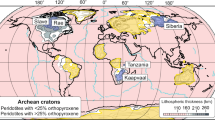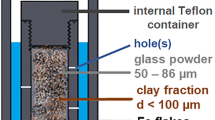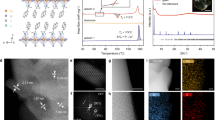Abstract
THE 50-cm-thick Cretaceous/Tertiary boundary layer at Beloc in Haiti contains spherules of silicic black glass, 1–8 mm in diameter, which have been attributed to impact fusion of continental crust1. Calcic yellow glass (up to 30 wt% CaO) forms a coating on and streaks within some black glass spherules, and has been attributed to melting of carbonate-rich sediment1, or organic-rich or pyritic limestone2. Here we present new trace-element and stable and radiogenic isotope data which show that the silicic glass is derived from continental crust of andesitic composition, whereas the high-Ca glass formed by melting of evaporite-rich sediment. This is confirmed by melting experiments with evaporite and andesite at 1,200–1,400 °C, which approximately reproduce the high-Ca glass. The temperature-dependent variation of sulphur content in synthetic high-Ca glasses indicates a formation temperature of 1,300 °C for the Haiti glasses. The geology of the impact site inferred from the geochemistry of the Haiti glasses matches the lithologies found in the 180-km Chicxulub structure, which occurs in Cretaceous evaporite deposits in Mexico. The high sulphur content of the calcic glasses suggests that the impact may have generated significant emissions of sulphur dioxide to the atmosphere, causing short-term global cooling.
This is a preview of subscription content, access via your institution
Access options
Subscribe to this journal
Receive 51 print issues and online access
$199.00 per year
only $3.90 per issue
Buy this article
- Purchase on SpringerLink
- Instant access to full article PDF
Prices may be subject to local taxes which are calculated during checkout
Similar content being viewed by others
References
Sigurdsson, H. et al. Nature 349, 482–487 (1991).
Izett, G. A. Lunar planet. Sci. 22, 625–626 (1991).
Oskarsson, N. et al. Lunar planet. Sci. 22, 1009 (1991).
Taylor, S. R. & McLennan, S. M. The Continental Crust: its Composition and Evolution 312 (Blackwell, Oxford, 1985).
White, W. M. & Patchett, J. Earth planet. Sci. Lett. 67, 167–185 (1984).
Migdisov, A. A., Ronov, A. B. & Grinenko, V. A. in The Global Geochemical Sulphur Cycle (eds. Ivanov, M. V. & Freney, J. R.) 25–127 (1983).
Claypool, G. E., Holser, W. T., Kaplan, I. R., Sakai, H. & Zak, T. Chem. Geol. 28, 199–260 (1980).
Rye, R. O., Luhr, J. F. & Wasserman, M. D. J. Volcanol. geotherm. Res. 23, 109–123 (1984).
Swihart, G. H., Moore, P. B. & Callis, E. L. Geochim. cosmochim. Acta 50, 1297–1301 (1986).
Wang, Y. L., Liu, Y. G. & Schmitt, R. A. Geochim. cosmochim. Acta 50, 1337–1355 (1986).
Palmer, M. R. & Elderfield, H. Nature 314, 526–528 (1985).
Butler, G. P. in The Persian Gulf (ed. Purser, B. H.) 423–452 (Springer, Berlin, 1973).
Cantagrel, J. M., Gourgaud, A. & Robin, C. Bull. Volcanol. 47, 735–748 (1984).
Prince, A. T. J. Am. Ceram. Soc. 37, 406 (1954).
Osborn, E. F., DeVries, R. C., Gee, K. H. & Kraner, H. M. Trans. AIME 200, 38–39 (1954).
Hlavac, J. The Technology of Glass and Ceramics 431 (Elsevier, Amsterdam, 1983).
Melosh, H. J. & Vickery, A. M. Nature 350, 494–497 (1991).
Jakes, P., Sen, S. & Matsuishi, K. Abstr. Lunar planet. Soc. Conf. 22, 633–634 (1991).
Hartung, J. B., Kunk, M. J. & Anderson, R. R. Geol. Soc. Am. Spec. Paper 247, 207–221 (1990).
Koeberl, C. & Hartung, J. B. Lunar planet. Sci. 22, 733–734 (1991).
Delano, J. W. & Lindsley, D. H. Geochim. cosmochim. Acta 46, 2447–2452 (1982).
Penfield, G. T. & Camargo, Z. A. Ann. Meeting Soc. Explor. Geophys. Abstr. 51, 37 (1981).
Pope, K. O., Ocampo, A. C. & Duller, C. E. Nature, 351, 105 (1991).
Bryant, W. R. et al. Am. Assoc. Petrol. Geol. Bull. 53, 2506–2542 (1969).
Lopez Ramos, E. Geologia de Mexico 2, 2nd edn (University of Mexico, Mexico City, 1979).
Wilhelm, O. & Ewing, M. Geol. Soc. Am. Bull. 83, 575–600 (1972).
Bateson, J. H. & Hall, I. H. S. Overseas Memoir 3, Inst. Geol. Sci., 44 (1977).
Kring, D. A., Hildebrand, A. R. & Boynton, W. V. Abstr. Lunar planet. Sci. Conf. 22, 755–756 (1991).
Sigurdsson, H. Paleogeogr. Paleoclim. Paleoecol. 89, 277–289 (1990).
Pollack, J. B. et al. J. geophys. Res. 81, 1071–1083 (1976).
Mosbah, M., Metrich, N. & Massiot, P. Nucl. Instrum. Meth. (in the press).
Turpin, L. et al. Contrib. Miner. Petrol. 104, 163–172 (1990).
Robin, C. Andesites (ed. Thorpe, R. S.) 137–147 (Wiley, New York, 1982).
Author information
Authors and Affiliations
Rights and permissions
About this article
Cite this article
Sigurdsson, H., Bonté, P., Turpin, L. et al. Geochemical constraints on source region of Cretaceous/Tertiary impact glasses. Nature 353, 839–842 (1991). https://doi.org/10.1038/353839a0
Received:
Accepted:
Issue date:
DOI: https://doi.org/10.1038/353839a0
This article is cited by
-
Titanium local coordination environments in Cretaceous–Paleogene and Devonian–Carboniferous boundary sediments as a possible marker for large meteorite impact
Physics and Chemistry of Minerals (2019)
-
Production of sulphate-rich vapour during the Chicxulub impact and implications for ocean acidification
Nature Geoscience (2014)
-
On Potential Spectroscopic Detection of Microfossils on Mars
Earth, Moon, and Planets (2007)
-
Yaxcopoil-1 and the Chicxulub impact
International Journal of Earth Sciences (2004)
-
Isotopic comparison of K/T boundary impact glass with melt rock from the Chicxulub and Manson impact structures
Nature (1993)



